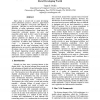Free Online Productivity Tools
i2Speak
i2Symbol
i2OCR
iTex2Img
iWeb2Print
iWeb2Shot
i2Type
iPdf2Split
iPdf2Merge
i2Bopomofo
i2Arabic
i2Style
i2Image
i2PDF
iLatex2Rtf
Sci2ools
WWW
2006
ACM
2006
ACM
Designing an architecture for delivering mobile information services to the rural developing world
Paper plays a crucial role in many developing world information practices. However, paper-based records are inefficient, error-prone and difficult to aggregate. Therefore we need to link paper with the flexibility of online information systems. A mobile phone is the perfect bridging device. Long battery life, connectivity, solid-state memory, low price and immediate utility make it better suited to developing world conditions than a PC. However, mobile software platforms are difficult to use, difficult to develop for, and make the assumption of ubiquitous connectivity. To address these limitations we present CAM ? a framework for developing mobile applications for the rural developing world. CAM applications are accessed by capturing barcodes using the phone camera, or by entering numeric strings with the keypad. Supporting minimal navigation, direct linkage to paper practices and offline multimedia interaction, CAM is uniquely adapted to rural user, application and infrastructure con...
Internet Technology | Mobile Software Platforms | Perfect Bridging Device | Rural Developing World | WWW 2006 |
| Added | 22 Nov 2009 |
| Updated | 22 Nov 2009 |
| Type | Conference |
| Year | 2006 |
| Where | WWW |
| Authors | Tapan S. Parikh, Edward D. Lazowska |
Comments (0)

